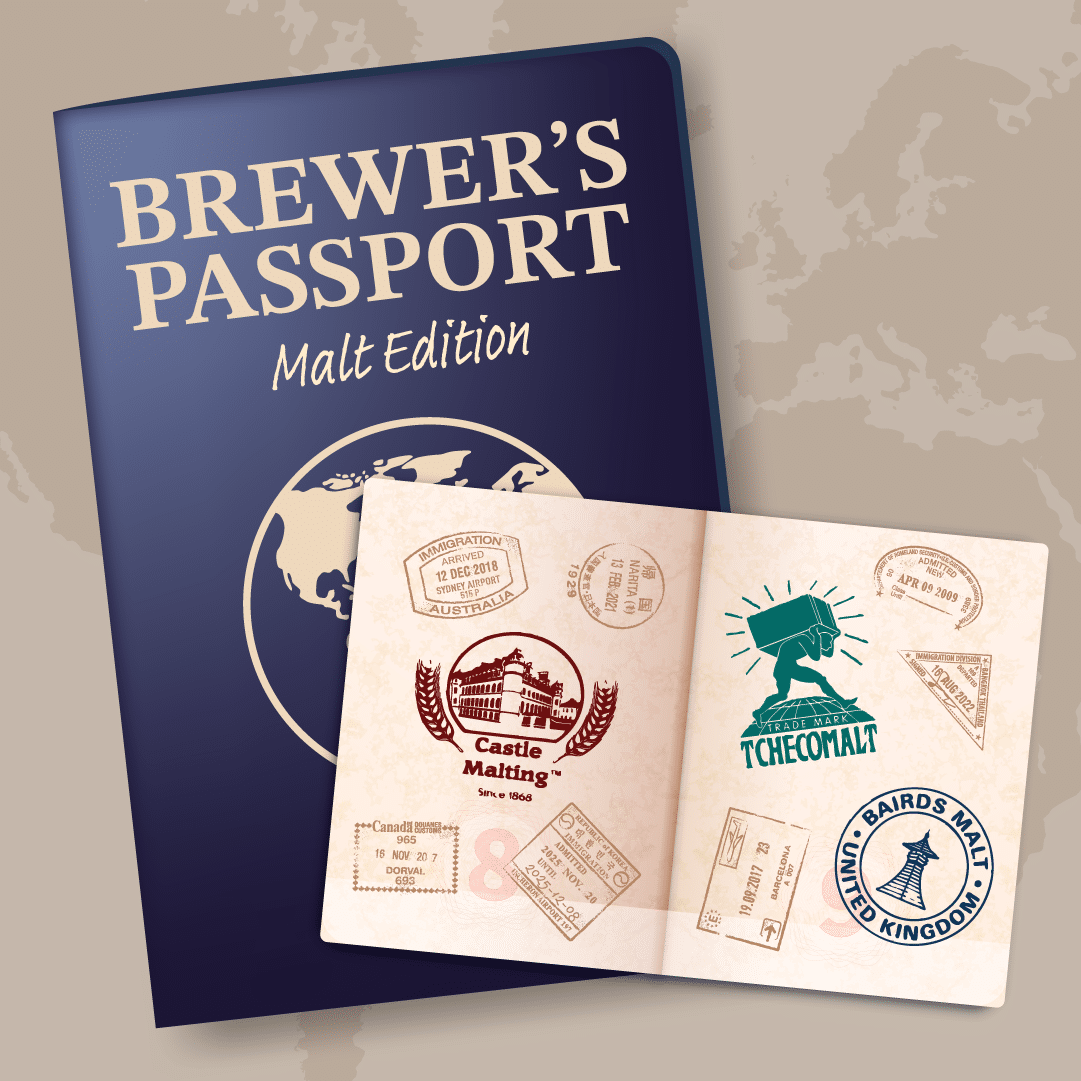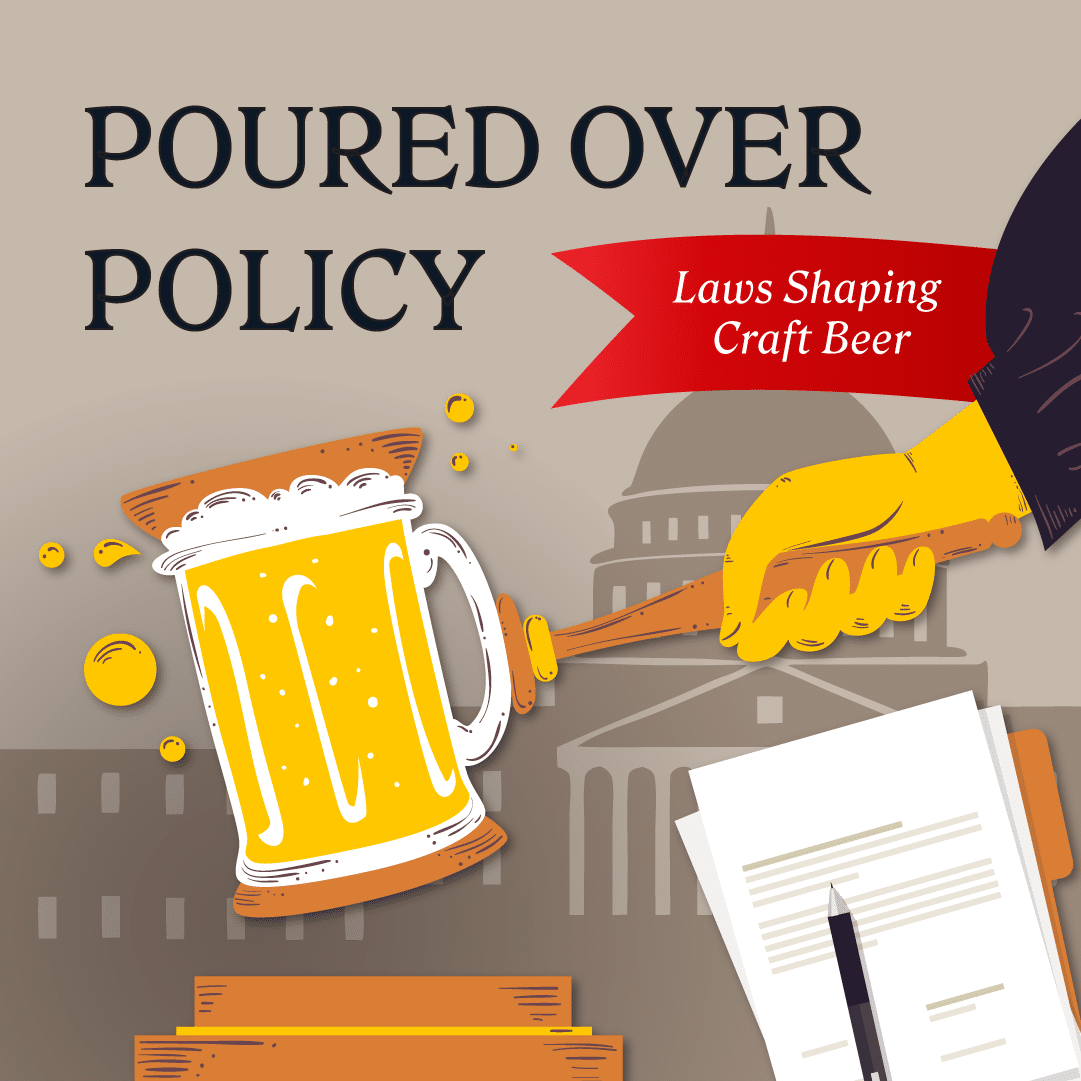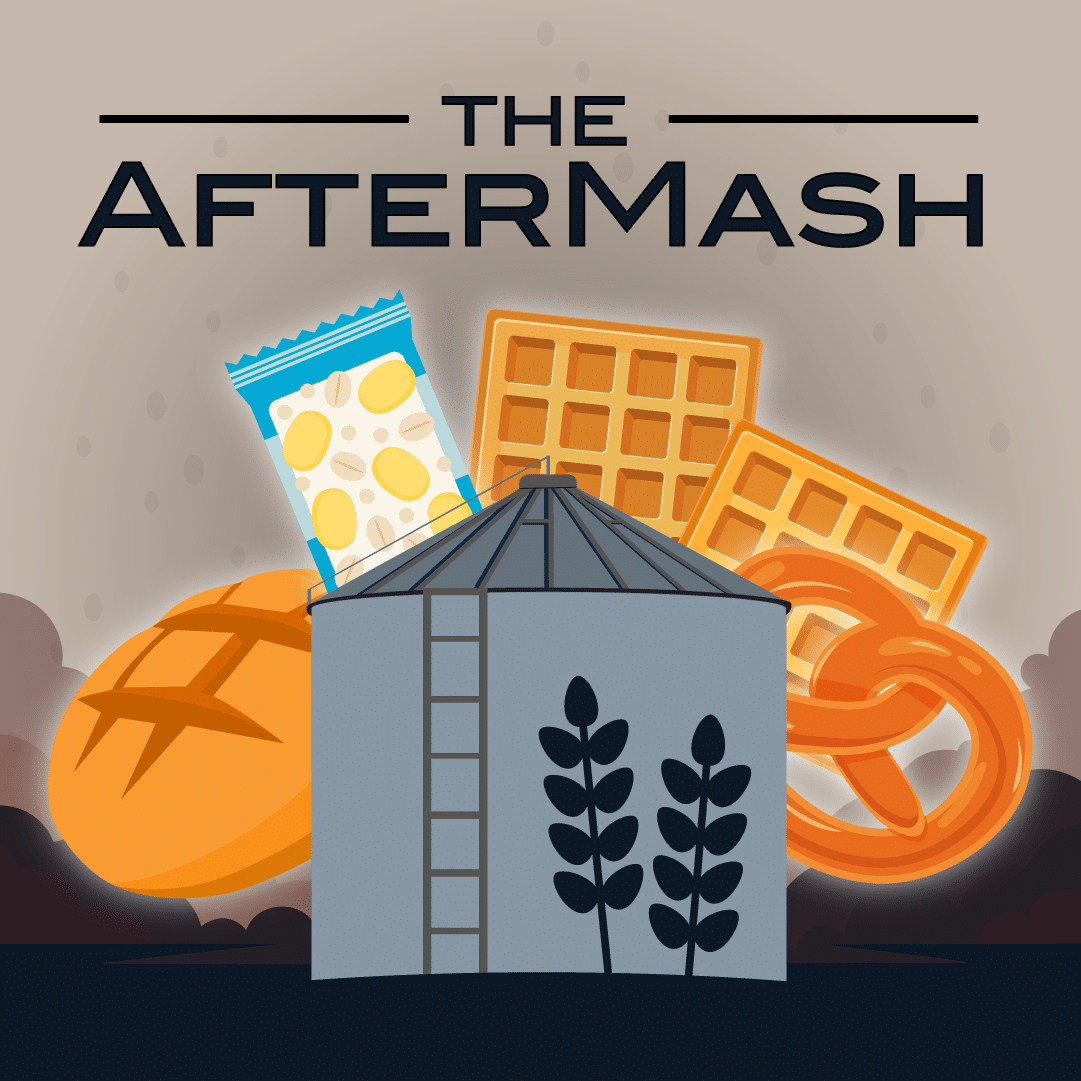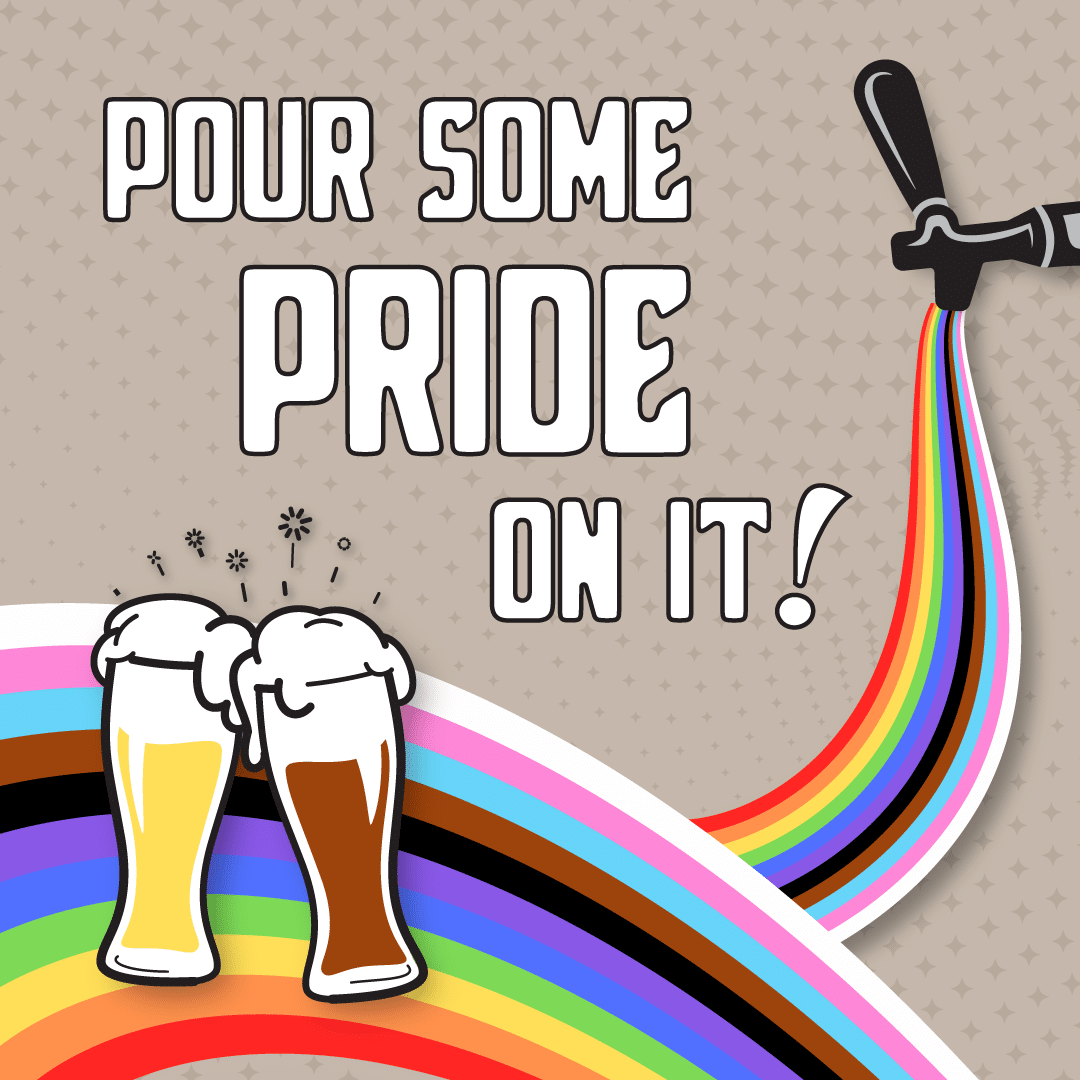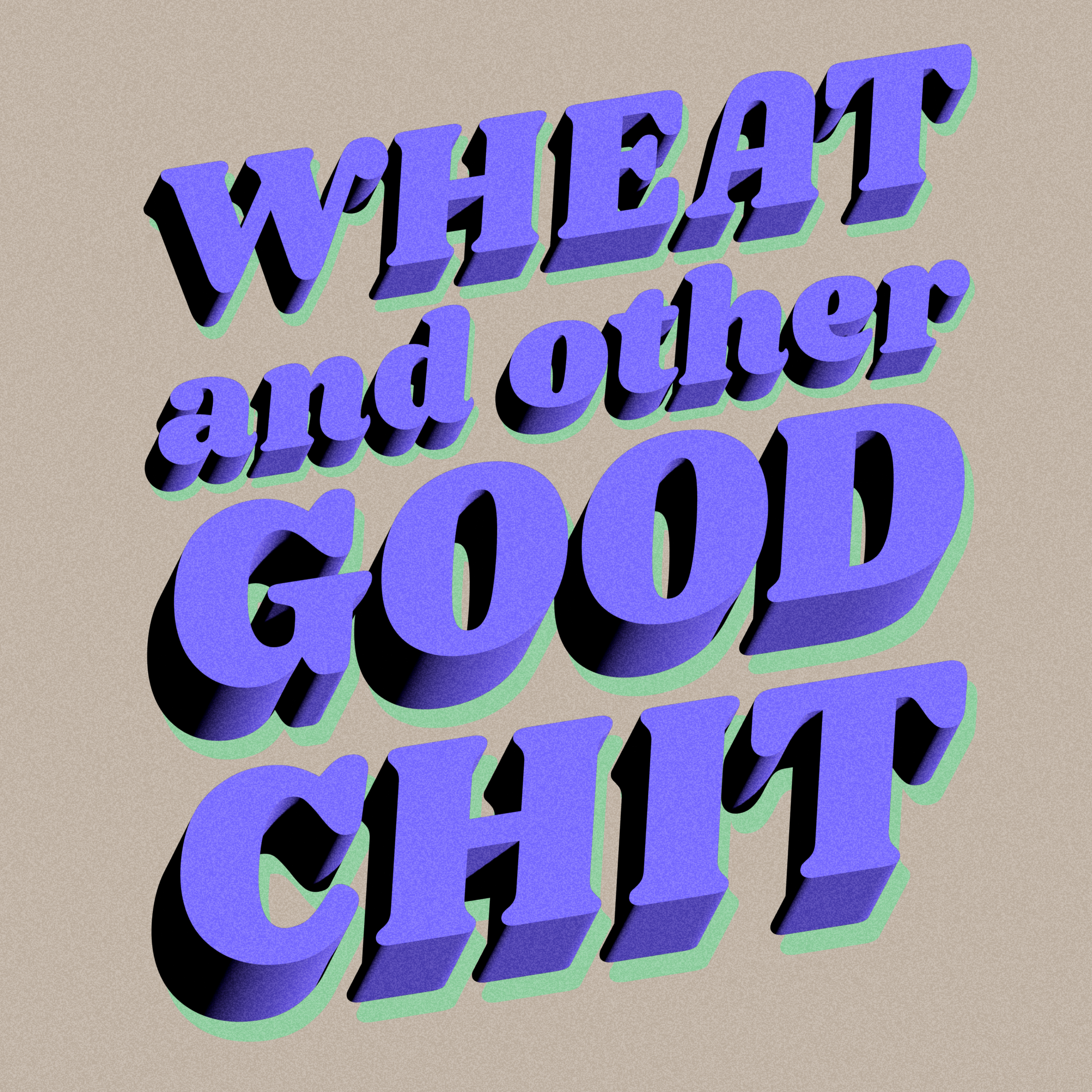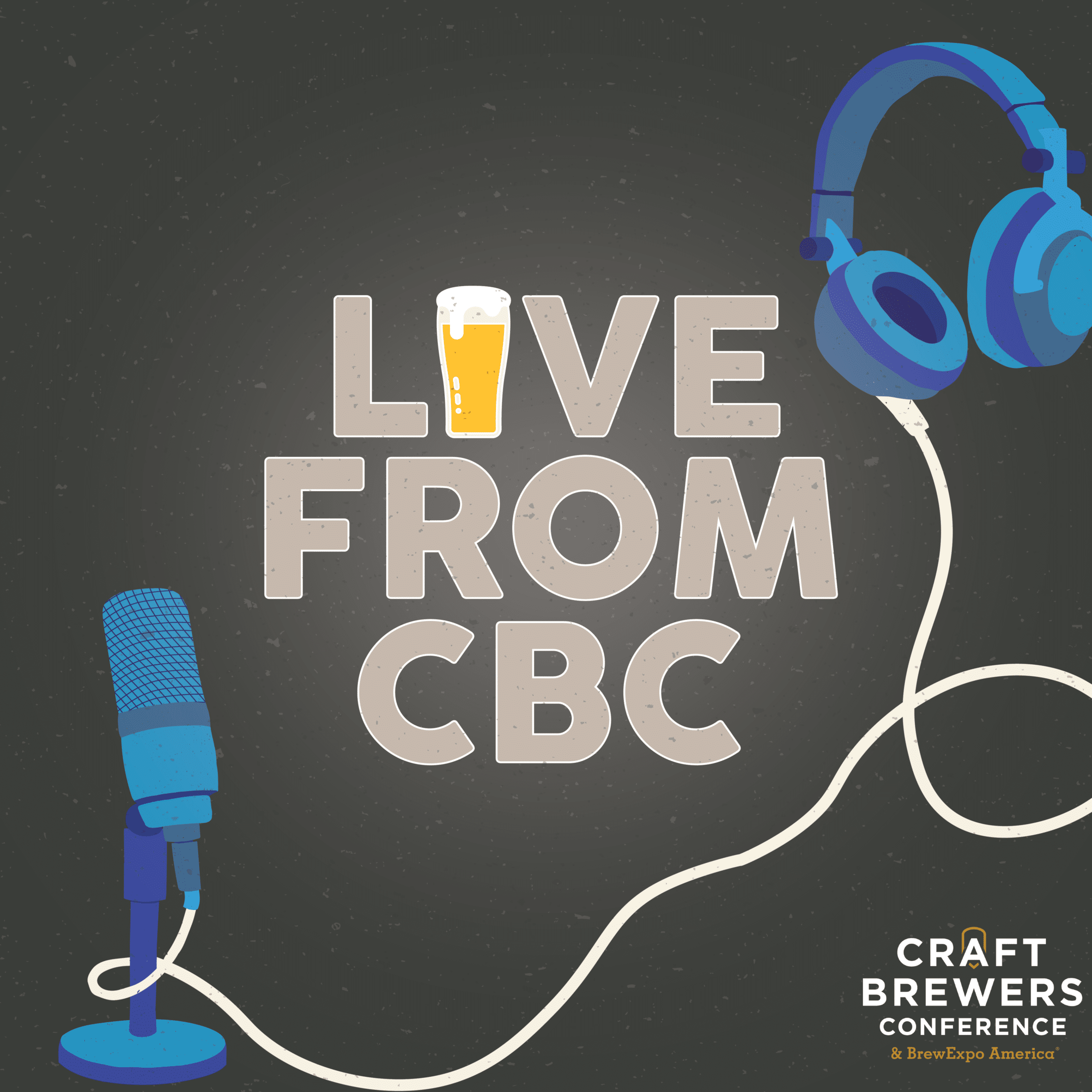
PODCAST GUESTS
Ian Ward

Prior to the current role Dr Ward served as the Chief Growth Officer for Rahr Corporation. Ian joined Rahr Corp in 2004, when Rahr acquired Brewers Wholesale Inc. forming the BSG business unit, distributing malt, hops and other brewing ingredients to the craft brewing, winemaking, and distilling industries. From 2004 until 2006 he led the sales team as Commercial VP and in 2006 was promoted to the role of President.
He has presented at numerous conferences and meetings throughout North America and Europe on the topics of enzymology, beer clarification and stabilization and latter on malt and hop industries.
Prior to his work in the U.S. Ian worked for Savilles Clarification, then part of the Laporte Group, as an R&D chemist. Published a number of papers on beer clarification and filed a UK Patent for a novel clarification procedure.
Ian received his Ph.D. in Organic Chemistry from the University of Birmingham in the UK, his research focused on using 1H and 13C nuclear magnetic resonance studies of borate complexes of phenol-formaldehyde polymers used as foundry binders. His undergraduate research focused on lithium ion conducting polymers
Marc Worona

Jeremy Marshall
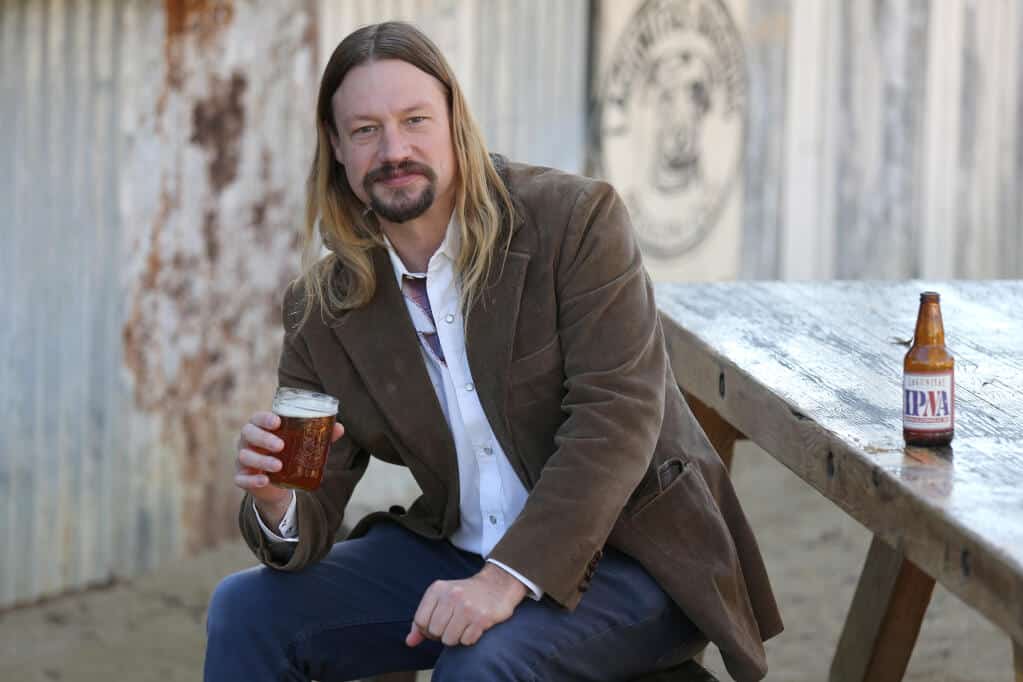
MORE EPISODES
SEASON 5, EPISODE 11: EVERYTHING BUT THE BARREL
PODCAST HOSTS:
HEATHER JERRED – TERRITORY MANAGER, COUNTRY MALT GROUP
ADAM WILSON – TERRITORY MANAGER, COUNTRY MALT GROUP
GUESTS:
IAN WARD – CEO, AROMA SCIENCES
MARC WORONA – AROMA SCIENCES
JEREMY MARSHALL – HEAD BREW”MONSTER”, LAGUNITAS BREWING
Key Points From This Episode:
- Introduction to Aroma Sciences and their products
- Discussion of the process and benefits of using Aroma Sciences extracts in beer, cider, and spirits
- Lagunitas Brewing’s experience using Aroma Sciences extracts in their beer
- Dosage rates and dosing methods for using Aroma Sciences extracts in beer
- Comparison of barrel aging versus using Aroma Sciences extracts
- Lagunitas Brewing’s plans for future use of Aroma Sciences extracts in their beers
Transcript - Everything But The Barrel
EPISODE S.5, E.11
[EVERYTHING BUT THE BARREL]
Heather (00:09):
Welcome back to another episode of the Brew Deck podcast. I am your host Heather, and I am joined by Adam Wilson. Hi Adam.
Adam (00:18):
Hello Heather.
Heather (00:19):
How are you?
Adam (00:21):
Fantastic, how are you?
Heather (00:22):
Oh, doing pretty good out here. You’ve got a busy little schedule ahead of you, hey?
Adam (00:29):
Yes, we’re smack dab in the middle of conference season. Just to wrap things up at CBC. Up here in Canada, we’ve got the Canadian Brewing Awards coming up this week and then next week heading out to Winnipeg, Manitoba for the Prairie Brewing Awards. So running around all over the place.
Heather (00:52):
That’s going to be a lot of fun. And good luck to everybody who entered. Speaking of awards.
Adam (00:57):
Of awards, let’s talk, let’s get some housekeeping out of the way here. For those, the World Beer Cup Vest Request closed this Friday, so if you won gold with our great Western Malting or Canada Malting Base Malts, make sure to let us know before Friday so you can get your gold Filson Vest. As well, the San Francisco World Spirits Competition vest request closed next Friday, which is May 31st. Double gold in the whisky category with at least 80% Great Western Malting or Canada Malting.
Heather (01:37):
You did it.
Adam (01:37):
I did. I got it out all of it.
Heather (01:37):
You did it.
Adam (01:39):
Canadian Brewing Awards, like I said, later this week, best of luck to everyone. We’re really looking forward to opening those first submissions starting next Monday.
Heather (01:47):
I can’t wait.
Adam (01:50):
So let’s get on to what we’re talking about today. Heather, what do we got?
Heather (01:53):
We are talking about a super cool and actually really interesting and innovative new product that we are carrying at Country Milk Group called Aroma Sciences. If you came to see us at CBC in Vegas, you may have already had the opportunity to try these brand new products because the guys were at the booth spraying cups and dosing some beers for people to try them. So we are going to be joined by Ian and Marc from Aroma Sciences today. And also, this is cool and I hope I didn’t fangirl out too much. We have Jeremy Marshall from Lagunitas coming on to talk about a beer that they produced utilizing the Aroma Sciences products.
Adam (02:37):
It’s really cool that we have the opportunity to get both from the folks at Aroma Sciences and somebody who has actually used it. Both perspectives, I think is super cool.
Heather (02:50):
So before we dive into that, if you want to learn a little bit more about actual barrel aging, go back and listen to season four, episode 26 entitled Aged to Perfection. We are featuring Cigar City Brewing and Martin House Brewing company where we talked all about barrel aging beers. Why don’t we dive in? We are now joined by Ian Ward and Marc Verona from Aroma Sciences. Welcome.
Marc (03:16):
Hi. Thanks for having us.
Ian (03:16):
Good to be here.
Heather (03:20):
Well, we’re super excited to talk all about Aroma Sciences today, but before we jump in, can you tell us a little bit about yourselves, how you got started in the industry?
Marc (03:31):
Yeah, sure.
Ian (03:33):
Who wants to go first?
Marc (03:34):
I’ll go first, Ian. How about-
Ian (03:35):
You go first.
Marc (03:36):
All right, so my beginning really was starting as a brewer back in the mid-90s. I worked in a now defunct brewery for 10 years and then made the transition to selling ingredients. I first started selling some hops and then joined up with Ian actually through Brewer Supply Group. Anyway, after about 15 years there, I transitioned over to Aroma Sciences and for the last year plus, I’ve been working with Ian to commercialize these extracts that we’ve developed.
Ian (04:07):
So my story is I’m a chemist by training, and you can work out from my accent, I’m from the UK. There wasn’t a lot of work available for chemists when I left university, and so I got a job in a company making Isingglass in the UK called Savils, and then had the opportunity to come over to the US and lead the technical for a little company called Brewers Wholesale, which was in Newport Rhode Island. And I got out on the West Coast and was selling Crisp Malt for a number of years, and that was acquired by Rahr. And I led the sales team for a while and then led the organization for about 15 years or so and then did some mergers and acquisitions for Rahr. And then a board member of Rahr introduced me to an inventor called Russell Thomas who made this pretty interesting invention that we’re going to talk about. And I was looking to do something a little bit different and have the opportunity to do so. And that’s where we find ourselves commercializing this really cool invention.
Heather (05:21):
It is a really cool invention. So why don’t you just dive right in and tell us exactly what Aroma Science is.
Ian (05:26):
Okay, yeah.
Heather (05:29):
Is?
Ian (05:30):
Yeah, is. So it’s all about commercializing this amazing invention. So Russell invented this process to extract the volatile components from plants. And first of all, he tried it with hemp and he built a successful business in the hemp world making CBD. And I don’t know if anybody knows about what’s happened in the hemp and cannabis space, but values have really crashed and seemingly it’s now cheaper to buy hemp and similar products than it was 20 years ago. And so it made it a pretty uneconomic proposition. But what was really amazing is the technology that Russell invented enables you to capture aroma compounds from an aromatic substrate, whether it be oak or rosemary or anything that’s got a smell to it. And it captures those aroma compounds in the same proportion as they exist in nature.
(06:36)
And if you think about any extract, if it’s an essential oil, the typical ways that essential oils are extracted is they use solvents. And so you would typically take, well, let’s use rosemary as an example. You would take the rosemary leaves, you would grind them up, and then you pour a solvent on top, could be alcohol, could be hexane, and then you allow it to steep for a while and the solvent penetrates the particle and then you strain off the solids and now you’ve got a solvent that hopefully contains the volatile extracts, the essence, if you will, of that plant.
(07:18)
And then you can either evaporate off the alcohol and you’ve got a nice smelling substance. The problem with that is that that’s not how we smell. When we smell something, if you think about perhaps a rose in a garden or a nice beer that you’re going to smell before you taste it, what’s happening there is the aroma molecules are evaporating from the surface of the rose or the glass of beer and it’s going into your nose and it gets there via evaporation. And smell is a really complicated process. And everybody should be aware I suppose that flavor, 80% of flavor is what you smell. So you can only really taste five things, sweet, salt, sour, bitter, and rummy. And then you’ve got piquancy and dryness and coolness, you think about mint. But everything else is smell. Everything else is smell either directly or retro nasally.
(08:19)
So if you use a solvent to make an extract, you’re hoping that that solvent extracts every compound that contributes to the flavor. And the reality is that it doesn’t. Solvents have specificity based on their polarity. So some solvents are very polar like water and some are very non-polar like gasoline. And different compounds sit along that polarity spectrum, if you will, at different points. And there’s no such thing as a universal solvent. So you might get an extract that smells of rosemary, but it will never have the complete beautiful authenticity as if you were to smell some rosemary on its own. And the reason is because flavor or aroma as I’ve described, is a very complicated, and some components have very, very strong flavors, but they only appear in minuscule amounts. And if your solvent happens to not be able to dissolve that compound, it’s lost.
(09:25)
And so you don’t have a very authentic representation. Well, this process Russell’s invented, uses heat and air and it evaporates the aroma molecules in the same way that you smell them. And so when we capture those into alcohol, we have this process where it’s effectively like a distillation. We evaporate the molecules and then we capture them. We can go into that in more detail, but you get a really authentic aroma. And so Russell applied that to oak. And when you smell these things, when you taste them, it’s like putting your head in a barrel. You really think you’re there. And so that’s exciting about this process, is that we’re able to make incredibly lifelike, natural extracts.
Heather (10:14):
Can confirm we all received our sample packs. We got to sample them while we were at CDC, we all received our little sample sprayers. And it is like sticking your head in a barrel.
Marc (10:26):
It’s so authentic that it triggers that aroma memory that’s in the brain and it really takes you back either to being in a rick house or in a winery or something like that where there’s a strong presence of oak in the air.
Adam (10:42):
So just getting a little ahead of ourselves here, you just explained the process of it all. So we are focusing, or Aroma Sciences right now is focusing on barrels, correct?
Ian (10:56):
Correct. Yeah. So Russell started this with, well, he started it with Rosemary to prove the concept, and then he moved into hemp to extract CBD because that was an exploding industry. I got connected with him because he was interested in applying this to hops because their sister plants or cousin plants, if you will. So he tried it with hops and he made some amazing extracts with hops. The thing about hops though is it’s only used in beer. And I’m sure everybody’s aware the hop market can be very turbulent and it is like, “Well, Russell, if you want to get into hops, there’s a lot of competition and what else can you do?” He said, “Well, I’ve tried barrels, and then when I put that through a flavor panel, the panelists were blown away.”
(11:50)
And so the opportunities exist in beer and in distilled spirits and RTDs and wine, but can we do this to other things? Absolutely, we can. And we’ve done it to amburana and we are working on some citrus extracts and other botanicals as a whole. We’re playing with all sorts of core herbs and spices. Yeah, we can talk a little bit about that, what’s to come in the future, but right now we’ve got six oak extracts and one amburana extract.
Adam (12:27):
So this primarily is for the sense for smell, but because you did mention that 80% of taste comes from smell, does this change the taste of the beer once you add?
Ian (12:45):
Yes, that’s absolutely-
Adam (12:48):
Excellent. So let’s start with the products. What products are we looking at here?
Marc (12:57):
Well, initially we started using wine barrels, so we were using French oak and American oak from them. And then we realized that there is a lot of demand for spirit character in beer and in spirits and RTDs themselves. So we are also processing bourbon barrels, we’re processing, extracting rum barrels. Ian mentioned about the amburana, which is a cachaça barrel Brazilian spirit. And so that has an entirely different type of aroma that’s really quite nice, quite cinnamony, a lot of baking spice, but different than the oak profile. But those are primary, I guess we also do brandy barrels as well too, which is a French oak. Most of these spirit barrels are going to be American oak originally, but the brandy barrel will have been French oak.
Adam (13:50):
I’m so interest… There’s so much to ask here. How similar is it to say barely when you’re with the final product?
Ian (14:04):
Yeah, so let’s talk about that specific to beer. Barrels and oak have been part of brewing history for hundreds and hundreds of years. If you think prior to economic stainless steel, fermenters would’ve been made of wood, would’ve been made of oak, and indeed beer would’ve been distributed in barrels. So for example, you can still find in Germany, in Munich, Munich Helles is packed in an oak cask. It’s turned extremely quickly. You can think about beer in Britain, cask-conditioned beer, many of them still Wadworth’s to this day serves beer from and certain accounts. The problem with oak is that it is porous and it’s hard to clean. In fact, it’s pretty impossible to clean from a brewer’s perspective. And so if you’re using it to transport beer, but the barrels are heavy, they’re hard to clean, and you’ve got to turn them incredibly quickly. Now it’s great if you’re in a beer hall in Munich where they ring the bell every 10 minutes because a new barrel is up and open and it doesn’t last very long.
(15:25)
But that’s not the reality we find ourselves in. And so stainless is a much better way of transporting beer and keeping it sanitary. But we’ve lost some of that nuance. If you go back and you look at the pictures of guys around the time of prohibition and you see those fellows with the bowler hats and the axes, they’re swinging them at wooden casks and you can tell it’s beer, not liquor, because there’s a huge amount of foam that you can see from these old black and white pictures. So beer was transported in oak, and beer that has a little kiss of oak has these amazing complexity, a little touch of vanilla, a little touch of oak lactones, and it has almost like a nutty character, coconut oak lactones taste of coconut. And it provides a complexity that is lost today. So that’s the application in beer. Obviously in wine and in liquor, it’s pretty self-evident. You have a very strong character.
Marc (16:36):
Also I would also add though that in higher concentration in beer, and not just when it has a touch of oak, but when it’s used, let’s say maybe over a thousand parts per million, it really does give the impression that the beer was barrel aged for an extended period in a spirit barrel. Now, because this liquid is a precise extract of the oak and you’re not really getting that aged long, aged contact time with oak, you’re not then getting a micro oxidation effect that you might potentially see in typical barrel aged beers. But it’s pretty easy to oxidize beer as we all know. So we can let that up to the brewers, to whoever’s in the cellar there. But as far as the actual oak flavor, oak character, spirit barrel type character, this is what this product can offer.
Ian (17:30):
And it does so without risk of infection. If you think about what wineries and distillers have to go through, brewing is much more difficult. You’ve got to be much more sanitary because you’re dealing with something that might only be four and a half, 5% alcohol. It’s really easy to infect that. What’s that expression? What does a brewer do when he not cleaning? He makes beer or she makes beer. You’ve got to be really scrupulously clean. Winemakers have a little more latitude because of the concentration of alcohol being so much higher. So brewers don’t have that luxury. So the use of these extracts allow brewers to put that oak into their process without any of the risk associated with microbial stability or indeed oxidation that Marc talked about.
Heather (18:24):
So when are you adding this into the beer? After fermentation?
Marc (18:30):
Yes, absolutely. You can add it straight into a bright tank as you’re making the transfer, if you know the volume of beer you’re going to end up with or you can add it after transfer. And because it’s not an oil or an emulsion, it’s a liquid that’s ethanol base, it’s completely miscible in the beer. And so just turn on a little bit of COO and it’ll mix immediately and be ready for packaging. And I should add, it’s clear and colorless as well. So if you are putting it into a clear beer, a clear filtered beer, it’s not going to affect the haze or turbidity.
Heather (19:09):
Can you tell me a little bit about the dosage rate?
Marc (19:12):
Yeah, sure. So at the low end, probably around 200 parts per million in a very mild a kolsch or light lager type of beer. And on the high end you can be up over a couple thousand parts per million. It really, I think, depends on the amount of oak impression that you want in the beer. It depends on the type of beer that you have. If it’s a very assertive flavored like an imperial stout, you’re going to need more than you would say in a porter or something like that. But also it depends on the concentration of the extract. Our spirit barrel based extracts have doubled the concentration of the French and American oak extracts, and so you could potentially get away with using less of those.
Adam (20:01):
Now, I’m guessing then depending on what you’re making, whether beer, cider spirits, you’re using different dosages as you go through? It’s not a one size fits all?
Marc (20:14):
That’s right, absolutely. We would recommend doing bench top trials really starting with about a hundred mil sample of the product that you’re looking to dose. And you just really ramp it up and see what suits you, what gives you the effect that you’re looking for.
Adam (20:33):
Oh, sorry, go ahead.
Ian (20:34):
So no, just to say to do that in the lab, it’s really easy to do. You just simply put aliquots of beer and then you can take a one mil syringe or you can take a micro pipette. And we have samples that we’ll talk about later, but you can just simply titrate it in, mix it, taste it, put it through the taste panel or just taste it yourself and then do the math. We’ve got some calculators that you can type in the volume of beer you want to treat and the rate and it’ll tell you how much to use, and then you just put it in the bright tank and then you just got to make sure you rouse it in with CO2 and that’s it. And it goes to package.
Adam (21:17):
Yes. You guys figured this all out before you came to market, didn’t you?
Ian (21:21):
Well, we spent about a year before we came to market. We had to go through a lot of steps in making sure the engineering work. It sounds a very elegant, simple process, but the engineering is really extraordinary and it’s well protected with the IP. And so we needed to make sure the engineering worked and then we needed to formulate recipes so that they can be very consistent. We did a lot of screening to make sure that the extracts are safe, so a lot of GCMS work to make sure that we’re not extracting things that are undesirable. And then we had to go through a lot of regulatory work to make sure that brewers can use this. And so the extracts are TTB approved, we’ve got numbers for on them all. So you submit a formula and this is an ingredient in the same way that black malt might be an ingredient. So you declare this and we’ve got all the data sets to allow that.
Marc (22:26):
FDA grass as well, generally regarded as safe grass.
Ian (22:31):
Yeah. So we did a lot of that work before we started talking to people about this. So yeah, a lot of paperwork.
Heather (22:40):
So Adam, I wanted to circle back a little bit. Adam brought up cider, so you could use this in cider. What are some other products other than beer or cider that you could see this being used in?
Marc (22:51):
Yeah, we have customers using it in seltzers or RTDs. If they’re looking to make a cocktail type RTD or seltzer, it can be used there to add a rum character to a mojito type base or a bourbon character to a Kentucky mule type. Or if you have a rum and coke desired effect and you can flavor up a cola with this and make a non-alcohol rum and coke, which is pretty effective and pretty convincing. So really, beer, cider distilled spirits, if you’re looking to accelerate the aging process and give more barrel character to a white whiskey, that’s a potential application there. But RTDs, it’s really unlimited. Anywhere you would like spirit character or barrel type spirit character in a beverage, it’s available.
Heather (23:54):
One of my favorite things that I heard about this and what customers were saying about this and they were so excited about it, is using it in non-alcoholic beers, being able to do “barrel aged” non-alcoholic. I think that just brings a really, really cool component to that NA market.
Marc (24:14):
Yeah, it is an alcohol based extract, so we have to be mindful of the usage rates. If you get too high, which would be really more than you would normally want to use in a product anyway. But a typical usage rate, if it’s under about 5,000 parts per million or even down to that 250, you’re always going to be less than that 0.5% alcohol. So it would be the beverage, final beverage would be characterized as non-alcohol. If you are using it in a beer that’s designed to be non-alcohol and there are other flavorings in it, you might want to understand what the ingredients are in the other flavorings because they could have a cumulative effect and you could exceed that 0.5 if you’re not careful. But with this product alone, generally you’ll be below that level.
Adam (25:01):
So how long has [inaudible 00:25:04], you’ve obviously done your homework beforehand, but how long have you actually been in market now and what feedback are you guys getting hearing back?
Ian (25:12):
So we did some test marketing a year ago is when we started to dip our toe into the water with just as Marc says, a couple of products. We are now getting really good feedback and people are returning and buying more in the beer space, in non-alcoholic, in wine and in spirits. So customers are returning and they’re liking it. And so it’s really quite exciting. We’re on that start of the J-curve. So it’s that fun part of building a business.
Marc (25:58):
One thing I would add is, it’s such a new product that it takes a little bit of education really to get the customers to understand what this product can do and how it’s different than traditional oak alternatives that have been on the market for ages. And like Ian said, one of the compliments that we get is really not on the product itself, but the fact that once a brewer is using it, they tend to return to use it again and they find other applications and start bringing in other flavors. And so once they wrap their head around it, they start really having fun with it and deciding where it can go from there.
Ian (26:34):
It’s probably worth mentioning other extracts. There are oak extracts available, but they’re all typically made using either that solvent extraction process, the solvent being boiling water or being alcohol or being a combination of the two. And the problem for brewers in that is that oak contains an awful lot of tannins, and especially with the aqueous extracts, if you introduce a lot of tannin to beer, it can throw a haze and that haze can be really unpredictable. So haze is great if it stays there, but if it appears or it disappears, it can be, an unstable haze can make a beer hard to control in the marketplace. And is it supposed to be hazy, is it not? So it can be hard to predict, whereas this doesn’t have an excess of reactive tannins that can react with beer proteins. So it’s a great tool and it’s very predictable. So the brewer can control the product and the level of haze or not and it not be affected.
Marc (27:56):
And I would add that even beyond the tannins and the stability issues that come along with them, this product compared to the others is much, much more aromatic, much more flavorful, much more authentic because as Ian discussed about the limitations of solvent extraction, this process of extraction is capturing everything. So we have the complete aroma, complete flavor profile of the oak, and so we’re able to offer something that the other extracts just don’t do.
Adam (28:27):
That’s awesome. I guess now’s the time. We’re just about ready to wrap up. So is there anything that we haven’t covered yet that our listeners should know about the product?
Ian (28:42):
Yeah, so just to let you know that, there’s going to be some samples available through Country Malt Group. You can approach your rep or I think you can either, eventually they’ll be online to be able to order a sample to get you going, get your head around how this works. Typically, it’s sold in a minimum of a liter and that’ll do probably about 10 barrels to give you an idea of use rate. But we sell it in larger quantities for larger brewers, 20 liters, a thousand liters we can go up to, but typically one liter. And the samples are a small one ounce bottle with some in just sufficient for lab scale. But it’s really about playing with it and experimenting with it. And then the other thing we’re doing, is that we have a research program that I’m leading to mess with other things. So we’ve got some other products coming down the pike.
(29:50)
One of them is going to be black lime. So we’ve got this really core source of black limes, which are kind like sun dried limes and they have this unique savory, it’s used a lot in Asian cuisine. They’re really nice. So we’re going through all of the work around TTP for that. And then we’ve got other things that we are going to be bringing in as time goes on, like orris root, which is used in gin manufacture. The sky’s the limit of what ultimately we can do, but we’ve got six products ready to go that are available now through Country Malt Group, and we’ll be adding as time goes on.
Adam (30:39):
I will say, the small little sample packs are pretty fantastic. We had them in, we them in a little spritzer and people were… Brewers were coming like a pack of dogs coming to a butcher. The smell just brought people over. It was pretty incredible to watch.
Ian (31:05):
We put them in these spritzer bottles so you can get an impression of the aroma, but when you’re doing the trials, you’d want to open it up and use a syringe and suck the liquid out and measure it precisely. The spritzers are just for fun to smell, but you measure it out in a syringe or in a micro prepared and dose it that way, but it’s pretty fun.
Marc (31:30):
One thing I would want to not be lost on the potential customers also is that if they already have an existing barrel program, these extracts can be used not necessarily to replace the program, but maybe enhance it. I know just working in the brewery myself, having put beer in a barrel, sometimes you just don’t quite get what you want out of that barrel. Maybe it’s been used, learned a few times in its prior life. So these can be really handy also for bumping up barrel character in existing barrel aged beers. So if you’re looking to dial in something, you’re just getting a little bit more out of it. It’s a good application there as well. So it’s a product that’s very economical compared to the cost of a new barrel, which is approaching two grand, I guess nowadays-
Ian (32:16):
For a French one, yeah.
Marc (32:18):
French oak. So between the economics and the time saving and just being sterile, so avoiding any contamination risk and it’s a really nice product to have, a good tool to have in your toolbox.
Ian (32:33):
Marc, you touched on one thing that I think might be worth explaining. There’s a reason why barrels are expensive. And the reason is, to grow an oak tree to a fairly modest size takes a hundred years. You can make from a 200-year-old oak tree, you can make six barrels, six barrels, that’s all. And you can age 60 gallons in each of those barrels. So a lot of the 200-year-old trees are now depleted. And yes, these forests are managed and planted, but we’re not treating it as a renewable resource because we’re gobbling them up faster than we’re able to plant them. Because it takes a hundred years. From a hundred-year-old tree, you can only get two barrels. So that grain has got to be tight, because you’ve got to hold that liquid. And so it’s incredibly costly. Not only to buy the barrel, but also to handle it. They’re very heavy.
(33:46)
If you look at a barrel and you look at a wine barrel, I live in wine country, all these wine barrels are sold off as planters. And when you look at them, you see a little bit of red. It doesn’t actually go very far into the oak. And so much of that oak that we’re harvesting from these trees of plus a hundred years, most of it’s not used to produce flavor in beverages. Most of it’s there just to hold the structural integrity of the barrel. So it’s incredibly wasteful and pricing of barrels reflects that. You’ve also got in the spirits industry, those barrels leak, if you will. They leak through the pores of the barrel. They don’t necessarily drip, but that so-called angel share, that evaporative loss is incredibly expensive. Depending upon the climate, you can lose single digit to almost double-digit percentage of liquid going in a year.
(34:51)
So if you’ve got a 20-year-old whiskey, half of that original volume has disappeared, that the distiller made. So you can understand why aged spirits are so costly, because it’s calculated at about 92 cents per bottle per year to buy that barrel, to put it in a rick house, to handle it, to have guys move them around in forklift trucks to the evaporative losses, the utilities of the building, the capital cost, it’s really expensive and it’s not great for the environment because of the wastage. So this does offer a much more efficient way of using this precious resource in a way that is more productive.
Heather (35:43):
The environmental sustainability aspect of it is quite fantastic.
Ian (35:49):
And there’s only three ingredients. Our energy input is electricity. The only other ingredients apart from oak is alcohol and water and that’s it. So it’s very easy to manage.
Heather (36:06):
So this might be asking who your favorite child is, but do you have a favorite of the barrel ones that we have out right now?
Marc (36:18):
My preference is for the rum barrel. I think it just has a beautiful spiritist character.
Heather (36:24):
That’s mine too. Yeah, it is so good.
Marc (36:29):
It checks a lot of boxes for me, so I really like it. The bourbon is a close second. The brandy is quite nice. You know what, I like them all, I guess. I will say this, amburana is really intense and it’s very unusual. To me, it’s very strong and it works well in the beer, I think when you put it in the right amount. When you spray it in the air, I find it to be very strong and sometimes it just gets my head spinning.
Ian (37:00):
So the trick is to make sure you don’t overdose it. These are strong. So that’s why it’s important to do trials and work the dose rate out and calculate. The amburana is really strong. Marc says it’s a very unusual aroma. It’s reminiscent of Tonka, which is not allowed in the US, but I’m liking the things I’m playing with. Orris root, which is one that we’re playing with is really interesting. But I like gin, so-
Heather (37:33):
I loved it.
Ian (37:36):
I like beer as well, but-
Heather (37:37):
Tonka is allowed in Canada, so just say.
Ian (37:39):
Yeah, it’s pretty cool. But yeah, the rum is really good.
Heather (37:46):
It just smells so good. Well, thank you very much Ian and Marc. We’re really, really lucky that you were able to take some time to come and chat with us about this. Reach out to your territory managers and your sales reps now, everything is available.
Ian (38:03):
It’s our pleasure. Many thanks, we had fun doing this.
Marc (38:06):
Yeah, thank you.
Heather (38:07):
Well, we are very lucky now to be joined by Jeremy Marshall. Jeremy is the head brew monster at Lagunitas Brewing. You’re going to have to explain the title a bit and say hi to the people. Tell us a little bit about yourself.
Jeremy (38:25):
Someone in HR, fun HR came up with that because I complained that brewmaster is, it is a little arrogant because no one really ever masters this. You just try to be really good at it. And then if you make a lot of mistakes, then you’re more like a monster, like Cookie Monster. Very, very messy. And I feel like it’s Cookie Monster of beer is more accurate. Haven’t mastered anything.
Adam (38:55):
That’s amazing. I’ve already got an image.
Jeremy (39:00):
Good visual. I know, I know. And I did hair and makeup not knowing this was audio only, so I got a pink wig on and some glitter. Just the usual Tuesday afternoon stuff.
Heather (39:17):
Is that the dress code down there?
Jeremy (39:17):
For the Cookie Monster of beer, yeah.
Heather (39:19):
Nice. Well, not that Lagunitas really needs an introduction to anybody that knows anything about beer, but if you tell us a little bit about your role and how long you’ve been there?
Jeremy (39:32):
Yeah. So Lagunitas is located in Petaluma, California, and the founder was from Chicago, so we have a second brewery there. So it is a northern California centric brand, but it has that Chicago dual identity. And I’ve worked here 20 years and it’s been quite the roller coaster. Not just here and at this brewery and then watching the overall explosion of craft breweries, but just the overall industry having come around in the, I call it the smoldering embers of the first great crash and burn of craft beer that happened in the 90s. When it first came under the scene, it got big and then it imploded. And then now we’re in this new era where we’re going through other cycles.
(40:31)
But it’s different now because back then, everyone had a quirky label, but there was a lot of really, really, really bad beer. And I think right now, thankfully brewers brew tremendously better beer everywhere, and it’s so easy to find good beer. And then now this whole thing beyond beer, whatever that means, or as I call it, bed, bath and beyond beer is how I like to call it. And all the crazy things we have to do now to keep the consumers engaged.
Adam (41:07):
I feel like we could have about three different podcasts from this conversation. Even before we hit record, we already had another one in the book, so this is great. But we’re going to focus on, let’s talk about the Aroma Sciences, which is what we’re here for today. We have had the conversation with our guys at Aroma Sciences, but we want to have a pretty candid conversation with a brewer who has actually tried and used the extract in the beer. So that would be you, my friend. For starters, what beer did you guys make with the extract and what extract did you use?
Jeremy (41:51):
So the beer that we made, it ended up being called Dark and Oaky. And the extract that we chose that I’m a big fan of is the amburana extract, which is also known as Brazilian Oak. I’ll have to explain cachaça now, but that’s a fermented and distilled sugar cane. And it’s different from rum in that it’s not just the refined sugar, it’s the whole kit and caboodle. It’s got everything in it and it’s very, very common and popular down in Brazil. And then the wood that they age and this would be like the Añejo equivalent if we were to borrow with tequila analogy. They would take the cachaça, which is clear age it on the amburana wood, and then that would be an aged one. And it would be, I don’t know, very cost prohibitive to get this a barrel.
(43:04)
And the brewers listening who have ever taken rum and tequila barrels, they know that it could be like the cartoon where the character gets a bunch of bullet holes and then drinks something and all the leaks come out. These barrels have been used many, many times. They come from warm places, so you’re gambling. And so that’s why I saw a tremendous value in what Aroma Sciences was doing here, which was getting the wood and using their rather cool technology, which it sounds like you’ve already got a chance to get that bit from them, to process it into a super easy to use extract that brewers love, things that you can just slap into the BBT.
(43:54)
We had our beer there waiting to go, and the base beer should talk a little bit more about that. It wasn’t really a porter, it wasn’t really a stout, it was a 5%, a mild that had some black malt, a lot of caramel malt. Definitely not hoppy, it was rich, but not super boozy or anything like that. Because we’re not designing a beer to put into a barrel here, we were doing the reverse of that. So we’re designing a beer to put the wood into that so you can put the beer in the BBT and get a little sample and then grab the bottle or the jug of the amber on a wood extract that we had from our own sciences. And then we would get the micropipette and do the whole bench top thing so that we make sure we have a ballpark of where we want to be.
(44:55)
And then this is a Lagunita secret that I’ll share with everyone that I think other brewers do this too. Whatever number we think we came up with, we always cut it in half because you can always add more, but it’s hard to take it away. And sometimes when you’re bench topping, it’s easy to not have it come over or it’d be a little different when you scale it up. So we put in the amount and got it dialed, and then we’re real happy with how it just transformed the beer. I always think barrels are like cocoons that beer goes in and metamorphosizes and it comes out different, but there’s that one recipe element that’s there that’s driving a lot of that, which is like micro oxidation. So in this case, we’re not oxidizing, we’re not actually aging the beer in the barrel letting oxygen play a role. And I think it brought over a new flavor set that’s novel.
Heather (46:04):
So how did you choose that one? I’m assuming you got to sample all of the products that they’ve got out now.
Jeremy (46:10):
Yeah, we did. We tried them all. They have a lot of French oak, American oak, bourbon, I don’t know if us brewers are allowed to use the word bourbon. There’s certain like the word is protected, like champagne.
Adam (46:26):
Like champagne.
Jeremy (46:28):
Yeah. But it’s like everybody knows what you mean. You could say whiskey. And I find all of their, there’s a lot of oak extracts out and anyone can take a wood and put it on some high proof and make their own extract. So what they’re doing is definitely far superior and getting a much deeper flavor. So we tried them all, and the amburana really popped out because it had a strong, almost like vanilla, cinnamon, cardamom, even hint of nut. It had all these spices in it that we could not believe were all coming from wood.
Heather (47:11):
Yeah, it’s a really interesting one. We were talking to the guys too. We went picking our favorites and that’s the one that they geared on as their favorite. Mine was the rum, but we’ll maybe try a beer with that later.
Jeremy (47:26):
Oh yeah, that was our runner up. And even when brewers can’t decide, they like to, “Oh, we’ll just do both.” And we came really close to doing a amburana and the rum, but then we were like, well, we really want to know which lever’s doing what. All that we know is probably what termites think, which is wood is good. And we know that wood is good, but we wanted to actually know which wood was good and which wood was doing what. So we went with all amburana and we have people that are convinced we added spices and vanilla to this beer and we can’t tell them what we didn’t, even though we know we didn’t. But they’re like, “Well, you’re a bunch of brewers and we don’t trust you. And you probably spilled something in there when you weren’t looking.” And I’m like, “No, there’s no spices in this.” And they’re like, “But I taste spices.”
Adam (48:21):
I guess you probably haven’t, I don’t know this, I’m just making an assumption because it’s such a weird exotic wood, that you haven’t had the chance to use one of those barrels before. But just in terms of barrel aging versus the extracts. Aside from timing, what do you find is the biggest difference or did you notice a big difference between the two?
Jeremy (48:48):
Well, as mentioned earlier, there’s no oxidation playing a role here. Definitely like you mentioned time, time being an actual ingredient of barrel aged beers. Now we have the lack of time also being its own flavor. And I do know that Marc and Ian and those guys have said they found ways to get those oxidative flavors, and maybe that’s more of a conversation with them. But in this case, I just felt like all I’m getting is the fresh wood character with all of the unique flavors. And whatever they’re doing to extract it’s not only more economical, I think it’s a lot more efficient.
(49:41)
So the fun thing is to be able to fill up right, and then peg off and have untreated and then treat the other half. And then you can have yourself a nice little side-by-side, which is tremendously engaging for your more beer geek centric type guests that want to come. You can really light them up here it is before and after and taste it that way too. And it’s just so easy. It’s so easy. Nothing can be harder than dealing with barrels and all of that. It’s just so much work and this is just so easy. And then the flavor is just, it’s very clean and rich. You don’t get any of that aged beer character. And not to say that that’s good or bad, it’s just a new lever. Imagine being able to barrel aged beer instantly, but without the age, so you’re just barrel on the beer without the barrel.
Heather (50:52):
Yeah, that’s really cool. We had a lot of really positive feedback from it when we launched this at CBC this year. A lot of really excited people. So I think it’s going to be a really cool one to see out on the market. Can you tell us a little bit about the dosing?
Jeremy (51:08):
Yeah. Okay, now I’m fighting through the brew monstery side, trying to remember what we did. I believe we hit it at approximately a liter and 10 hectoliters. So that’s exactly a hundred mils per hectoliter. Or if you’re a barrel guy or gal, that’s going to be about a 120, a 117, a 120 mills. And that was heavy because we really wanted to put it out there. We wanted to put it in their face like, you’re going to detect this. Definitely the half rate is noticeable. There’s always that where is a threshold trigger, and I think you could achieve that in the more 40 to 50 mil. My brain was already thinking, this would be really fun stuff to try in some lighter beer styles. Now that every brewer is doing everything, there’s nothing off the table. You can butcher any style and people seem to be okay with it. Why not?
Heather (52:21):
There’s no rules anymore.
Jeremy (52:23):
No rules. Take a fine traditional German lager or a kolsch and then hit it with just a touch of one of these wood extracts and see what you get. And they’re so elegant and subtle it will not mess up the beer. But back to the concept mentioned earlier, always good to pull the micropipette out and make some bench tops and then add to your BBT with a measured, a restrained hand just in case.
Adam (53:00):
The founding fathers of the Ryan House are rolling in their graves, waving their fists at you right now. But I think-
Jeremy (53:08):
I think they live forever though. Aren’t they in a state of suspended animation? Didn’t we keep those guys alive?
Heather (53:19):
Are they in the yeast, in the grain bank? Is that where we keep them?
Jeremy (53:19):
Yeah, we keep them. Yes, they are banked right next to all of the finest lager strains in that same freezer. That’s where these men are. I’m going to assume they were men. Hopefully there was-
Heather (53:31):
That’s probably true.
Jeremy (53:32):
Yeah. Anyone that can tinker us in particular.
Adam (53:40):
That’s awesome. Okay. I’ve got one last question for you before we wrap this up. Now that you have used it in the Dark and Oaky, are you planning on using any of the other ones moving forward?
Jeremy (53:53):
Oh, absolutely. Definitely the rum, that was our number two. I think I need to get back into, that’s just some of the American oaks in exploring the whiskey bourbon flavors. One additional note that we are doing is we withheld a few Dark and Okie kegs, and we are actually debarrowing those back into the bright to knock the CO₂ down, and we’re going to nitro them because I realized I really missed an opportunity because the spicy character of the Aroma Sciences extract plays so well with that creamy nitro. So that’s my immediate move. That’s what I’m doing literally this week. I’m not doing it, Marc is doing it. And Marc is definitely the Nitro doctor. But I think, well, the next one we’re going to play around with is probably going to be either the rum or the whiskey.
Adam (54:54):
That’s phenomenal. Yeah.
Heather (54:54):
That sounds delicious.
Adam (54:58):
Factor in the monsters, fantastic. Lagunitas has it covered right now. That’s phenomenal. Jeremy, thank you so much for taking the time today to go through this with us, and we’re really, really glad that you came on here and had this chat with us. And stop by the brewery and drink all of Jeremy’s beer and especially try the Dark and Okie if there’s any left.
Jeremy (55:26):
Yeah, thanks for having me. And I’m excited to see what these guys come up with next because they have that startup mentality, which means they grind and they think. They’re not complacent, so they’re going to keep knocking it out of the park, I think.
Heather (55:41):
Yeah, the wheels are definitely turning. You could tell.
Jeremy (55:43):
Yeah.
Heather (55:44):
Yeah.
Jeremy (55:44):
Who knows what they’ll extract next.
Heather (55:46):
Yeah, no doubt. Awesome. Well, thanks so much, Jeremy.
Jeremy (55:49):
Okay. Yeah, thanks for having me.
Adam (55:53):
Thanks to our guests, Jeremy Marshall from Lagunitas. That was really cool to speak to him. He’s really knowledgeable for a Cookie Monster who wears Pink wig. And obviously Marc and Ian from Aroma Sciences. These guys know their stuff. They’re hungry, they’re putting out really, really cool products right now. So if you are interested in learning more, sampling or ordering Aroma Sciences, reach out to your CMG sales rep, please.
Heather (56:28):
And it is almost June, so you know what that means. It is Pride Month. We’re going to be back in two weeks for our annual pride episode, and we have some really, really cool guests lined up, so stay tuned for that. And also on the street, there’s going to be a very special little giveaway going on during Pride Month. So yeah, make sure to take a listen in a couple weeks. Make sure to subscribe wherever you listen to your podcast and we’ll see you in a couple weeks.
Adam (56:56):
Bye.
Heather (56:56):
Bye.

